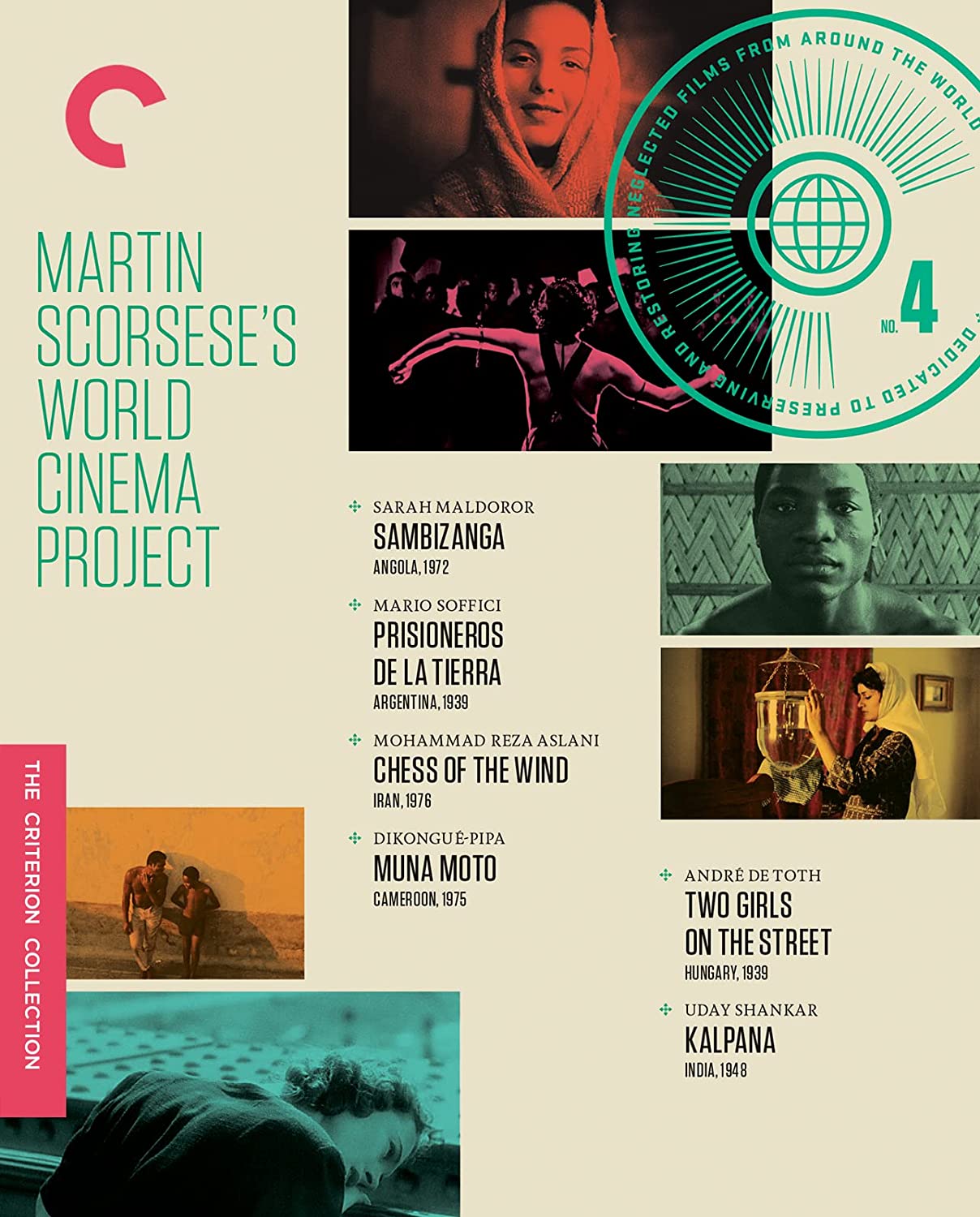 Martin Scorsese’s World Cinema Project No. 4 will release on September 27, 2022 in a 9-disc collection from The Criterion Collection. The edition includes six important but overlooked works from Angola (Sambizanga), Argentina (Prisioneros de la tierra), Iran (Chess of the Wind), Cameroon (Muna moto), Hungary (Two Girls on the Street), and India (Kalpana).
Martin Scorsese’s World Cinema Project No. 4 will release on September 27, 2022 in a 9-disc collection from The Criterion Collection. The edition includes six important but overlooked works from Angola (Sambizanga), Argentina (Prisioneros de la tierra), Iran (Chess of the Wind), Cameroon (Muna moto), Hungary (Two Girls on the Street), and India (Kalpana).
Dual-Format Blu-ray & DVD Special Edition Features
- New 4K digital restorations of Sambizanga, Prisioneros de la tierra, Chess of the Wind, and Muna moto, and 2K digital restorations of Two Girls on the Street and Kalpana, all overseen by The Film Foundation’s World Cinema Project in collaboration with the Cineteca di Bologna, with uncompressed monaural soundtracks on the Blu-rays
- New introductions to the films by World Cinema Project founder Martin Scorsese
- New and archival interviews featuring Indian film historian Suresh Chabria and filmmaker Kumar Shahani (on Kalpana); Argentine film historians Paula Félix-Didier and Andrés Levinson (on Prisioneros de la tierra); Two Girls on the Street director André de Toth; and Sambizanga director Sarah Maldoror and Annouchka de Andrade, Maldoror’s daughter
- New program by filmmaker Mohamed Challouf featuring interviews with Muna moto director Dikongué-Pipa and African film historian Férid Boughedir
- The Majnoun and the Wind (2022), a documentary by Gita Aslani Shahrestani, daughter of Chess of the Wind director Mohammad Reza Aslani, featuring Aslani, members of the film’s cast and crew, and others
- New and updated English subtitle translations
- PLUS: A foreword and essays on the films by critics and scholars Yasmina Price, Matthew Karush, Ehsan Khoshbakht, Aboubakar Sanogo, Chris Fujiwara, and Shai Heredia
SAMBIZANGA
A bombshell by the first woman to direct a film in Africa, Sarah Maldoror’s chronicle of the awakening of Angola’s independence movement is a stirring hymn to those who risk everything in the fight for freedom. Based on a true story, Sambizanga follows a young woman (Elisa Andrade) as she makes her way from the outskirts of Luanda toward the city’s center looking for her husband (Domingos Oliveira) after his arrest by the Portuguese authorities—an incident that ultimately helps to ignite an uprising. Scored by the language of revolution and the spiritual songs of the colonized Angolan people, and featuring a cast of nonprofessional actors—many of whom were themselves involved in anticolonial resistance—this landmark work of political cinema honors the essential roles of women, as well as the hardships they endure, in the global struggle for liberation.
PRISIONEROS DE LA TIERRA
The most acclaimed film by one of classic Argentine cinema’s foremost directors, Mario Soffici’s gut-punching work of social realism, shot on location in the dense, sweltering jungle of the Misiones region, simmers with rage against the oppression of workers. A group of desperate men are conscripted into indentured labor on a treacherous, disease-ridden yerba maté plantation under the control of the brutal foreman Köhner (Francisco Petrone)—a situation that boils over in an explosive act of rebellion led by the defiant Podeley (Ángel Magaña), and made all the more tense by the fact that Köhner and Podeley love the same woman: Andrea (Elisa Galvé), the sweet-spirited daughter of the camp’s doctor. The expressionistic, shadow-sculpted cinematography of Pablo Tabernero evokes the feverish dread of a place where suffocating heat, economic exploitation, and unremitting cruelty lead inexorably to madness and violence.
CHESS OF THE WIND
Lost for decades after screening at the 1976 Tehran International Film Festival, this rediscovered jewel of Iranian cinema reemerges to take its place as one of the most singular and astonishing works of the country’s prerevolutionary New Wave. A hypnotically stylized murder mystery awash in shivery period atmosphere, Chess of the Wind unfolds inside an ornate, candlelit mansion where a web of greed, violence, and betrayal ensnares the potential heirs to a family fortune as they vie for control of their recently deceased matriarch’s estate. Melding the influences of European modernism, gothic horror, and classical Persian art, director Mohammad Reza Aslani crafts an exquisitely restrained mood piece that erupts into a subversive final act in which class conventions, gender roles, and even time itself are upended with shocking ferocity.
MUNA MOTO
Director Dikongué-Pipa forged a new African cinematic language with Muna moto, a delicate love story with profound emotional resonance. In a close-knit village in Cameroon, the rigid customs governing courtship and marriage mean that a deeply in love betrothed couple (David Endéné and Arlette Din Belle) can be torn apart by the lack of a dowry and by another man’s claiming of the young woman as his own wife—a rupture that sets the stage for a clash between a patriarchal society and a modern generation’s determination to chart its own course. Luminous black-and-white cinematography and stylistic flourishes yield images of haunting power in this potent depiction, told via flashback, of the challenges of postcolonialism and the devastating consequences of a community’s refusal to deviate from tradition.
TWO GIRLS ON THE STREET
The maverick Hollywood stylist André de Toth sharpened his craft in his native Hungary, where he directed five films, including this chic, dynamically paced melodrama studded with deco decor and jazzy musical interludes. Mária Tasnádi Fekete and Bella Bordy sparkle as upwardly mobile working women—one a musician in an all-girl band, the other a bricklayer—who join forces as they both try to make it in Budapest, supporting each other through changing economic fortunes, the advances of lecherous men, and the highs and heartbreaks of love. Kinetic camera work, brisk editing, and avant-garde imagery abound in Two Girls on the Street, an often strikingly modern ode to the power of working-class female solidarity.
KALPANA
A riot of ecstatic imagery, performance, and set design, the only film by the visionary dancer and choreographer Uday Shankar is a revolutionary celebration of Indian dance in its myriad varieties and a utopian vision of cultural renewal. Unfolding as an epic film within a film, Kalpana tells the story of an ambitious dancer (Shankar) determined to open a cultural center devoted to breathing new life into India’s traditional artistic forms; meanwhile, the obvious adoration between him and his lead dancer (Shankar’s wife and collaborator, Amala Uday Shankar) arouses the jealousy of his enterprising companion (Lakshmi Kanta). Swirling surrealist dance spectacles—featuring dance masters and young performers, many of whom would become stars in their own right—are interwoven with anticolonial, anticapitalist commentary for a radical, proto-Bollywood milestone that is one of the most influential works in Indian cinema.












